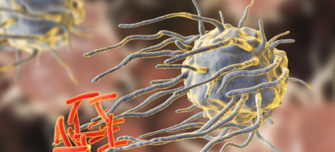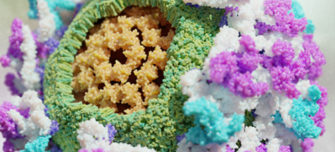The life cycle of pathogens and how they spread

What are pathogens?
A pathogen is a micro-organism that has the potential to cause disease. An infection is due to the invasion and multiplication of pathogenic microbes in an individual or population. There are a number of different types of pathogenic organisms associated with disease including viruses, bacteria, protists and fungi.
Pathogens can spread in a number of different ways including via direct contact, water or air. Different pathogens can be spread by different mechanisms, for example malaria is transmitted by mosquitoes, cholera is transmitted via water and HIV is transmitted via bodily fluids.
Most viruses are much smaller than bacteria and not only do they enter cells in the body, they reproduce inside cells hundreds of thousands of times. Eventually a virus will pass out through the airways or the bloodstream and can spread across populations. Examples of viral infections are the flu (influenza), measles, mumps, the common cold and AIDS.
Viral vectors
There are several types of viral vectors that can be used to deliver nucleic acids into the genetic makeup of cells including retrovirus, lentivirus, adenovirus, adeno-associated virus and herpes simplex virus–each with its own advantages and disadvantages for specific applications.
Viruses such as malaria and yellow fever use mosquitoes as a vector which is an organism which spreads pathogens from one host to another. To prevent individuals from vector-borne diseases, the vectors need to be controlled by measures such as spraying insecticide to reduce the population of insect vectors. This however, can be a more complex and expensive method of controlling disease.
If a disease is highly contagious, people have to be isolated to prevent the infection spreading to others. Vaccination is also an option for preventing and reducing pathogens and work by putting a small amount of inactive or dead pathogens into the body to produce antibodies. Learn more about vaccination in our digital content hub exploring 'How vaccines work'.
Why does understanding the life cycle of pathogens and how they spread matter to microbiology?
Pathogens cause illness to their hosts in a variety of ways. Due to their diversity and ability to replicate, developing a deeper understanding of the life cycle of pathogens and their impact on the immune system function is underpinning the development of new tools to diagnose, prevent and treat infectious disease.
Given the emerging threat of antimicrobial resistance, there is an urgent need for novel therapeutics to be developed, one of which is phage therapy. Phage therapy is the therapeutic use of bacteriophages to treat pathogenic bacterial infections.
Read more about why understanding the life cycle of pathogens and how they spread matters to our members and the wider microbiology community, access our additional resources and continue to read more about why understanding viruses matters to microbiology as we explore emerging viruses.
-
Microbiologists working in this area
To celebrate our 75th anniversary in 2020, we invited microbiologists to nominate the discovery or event that best showcases why microbiology matters and helps us demonstrate the impact of microbiologists past, present and future. Learn more about the microbiologists who are working to understand more about the life cycle of pathogens and how they spread.
-
Resources and further reading
Discover more about the opportunistic pathogens in hospitals, the air-borne spread of foot-and-mouth disease, and what researchers have found when investigating how viruses spread between marine animals.
-
Emerging viruses
Over the years a number of novel pathogens continue to emerge in human, domestic animal, wildlife and plant populations. Emerging and re-emerging viruses will be a continuing threat to human health because of their amazing potential to adapt to their current hosts, to switch to new hosts and to evolve strategies to escape antiviral measures.
Image credits:
Transmission Electron Micrograph of Murine Norovirus. Joseph Snowden
iStock/Dr_Microbe
Cameron Baines





